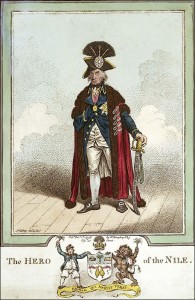All links are to Wikipedia entries.
Government, Politics, and War:
- February 1: Napoleon occupies Rome.
- February 10: The papacy is removed from power by French General Louis Alexandre Berthier.
- March 7: French forces invade the Papal States and establish the Roman Republic.
- April 26: France annexes Geneva.
- May 23: The Society of United Irishmen spearhead the Irish Rebellion against British rule, which lasts through the end of summer when the British finally put down the rebellion.
- May: Napoleon dispatches 167 scientists in an expedition to Egypt, as a prelude to a military expedition.
- May 18: Richard Wellesley (Earl of Mornington and later Marquess Wellesley) becomes Governor-General of India.
- June 12: Napoleon seizes Malta from the Order of St. John (Knights Hospitallers).
- July 1: Napoleon enters Egypt, and fights successfully against the greater forces of the Marmelukes in the Battle of the Shubra Khit and the Battle of the Pyramids.
- July 24: Napoleon occupies Cairo.
- August 1: Nelson is victorious at the Battle of the Nile, capturing or destroying all but two French ships of the line, stranding Napoleon in Egypt, and frustrating his plans to strengthen the French position in the Mediterranean. His brilliant victory gains him the title Baron Nelson of the Nile.
- August 22: French troops land at Kilcummin in County Mayo to assist the Irish rebellion.
- October 12: At the Battle of Tory Island, a British Royal Navy squadron prevents French Republican ships from landing reinforcements for the Society of United Irishmen on the Donegal coast; Irish leader Wolfe Tone is captured and later dies of wounds.
Society and Social History:
- June 4: Italian adventurer and writer Giacomo Casanova dies at age 73 .
Literature, Journalism, and Publishing:
- William Godwin publishes Memoirs of the Author of A Vindication of the Rights of Woman, a biography of his late wife, Mary Wollstonecraft.
- January: The first monthly issue of the Lady’s Monthly Museum is published.
- September 18: William Wordsworth and Samuel Taylor Coleridge publish Lyrical Ballads (anonymously, in part because they wish to avoid Coleridge’s stigma as a “Jacobin radical”), including “Rime of the Ancient Mariner” and “Lines Written Above Tintern Abbey.”
Art, Architecture, and Design:
- François Gérard exhibits Cupid and Psyche at the Salon of 1798, demonstrating neoclassicism’s evolution towards sensuality and a certain formal abstraction.
Music:
- Beethoven composes the “Pathétique” Sonata (Piano Sonata No. 8 in C minor, Opus 13).
- September: Haydn’s Mass in D minor (Nelson Mass) is premiered at the court of Prince Nicolaus II Esterházy of Hungary. He has written the work without knowing of Nelson’s victory in the Battle of the Nile, but people will soon begin calling it the Nelson Missa.
Theater and Dramatic Arts:
- The first volume of Joanna Baillie’s Plays of the Passions is published anonymously.
- October: Elizabeth Inchbald’s play Lover’s Vows is performed for the first time at Covent Garden. It is an immediate success, but gains even more fame when it is featured in Jane Austen’s novel Mansfield Park.
Natural History and Exploration:
- August: Napoleon establishes the Institut d’Égypte, staffed with French scholars and scientists who are charged with the research, study and publication of physical, industrial and historical facts about Egypt, especially its tombs and temples.
- November 8: British whaler John Fearn becomes the first European to land on Nauru.






